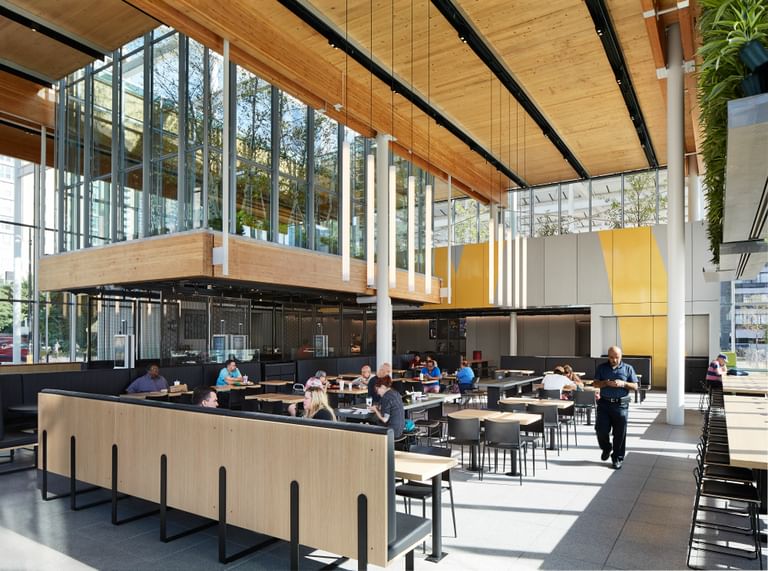McDonald's Flagship receives LEED Platinum Certification
Platinum certification is the highest level of achievement from the globally recognized program LEED (Leadership in Energy and Environmental Design). The McDonald’s Flagship becomes the first fast-food restaurant to receive platinum certification and joins a short list of seven retail buildings to do so.
The Chicago location radically deviates from a typical prototype restaurant, setting a precedent for all buildings, no matter their energy intensive profile, to meet sustainability targets through thoughtful design, construction, and operation. Submitted under LEED version 4 + 4.1, the project addresses many critical categories:

Location and Transportation
Steps from multiple bus, train, and bicycle networks, the project is well positioned to support multi-modal access. Sandwiched between arterial roads the heavily landscaped site is an an urban living room for the growing River North community; complete with an integrated public park.
Sustainable Sites
92% of the open site area is comprised of permeable pavers and native & adaptive landscaping, reducing storm-water runoff. Biodiversity is bolstered by the 11% increase (from the prior development) in landscaped area containing over 10,500 plants and 35+ species of plants, trees, fruits, and vegetables.
Water Efficiency
Two intensive green roofs cover 14% of the total roof area with the ability to hold over 7,000 gallons of storm-water. Roof drains funnel storm-water to underground storm sewers, directing water to a 65,000-gallon underground storage tank for slow release into the city system. Slowing the release of storm-water to the city system decreases the burden on infrastructure – a growing problem in impervious urban environments like Chicago.
Energy and Atmosphere
A “solar pergola” composed of 1,062 south-facing panels generates ~59% of the building’s overall electrical energy needs while providing generous shading. Two years of data show the solar panels consistently out-performing modeled estimates, including four months of generation beyond consumption. This level of success is a lesson learned for urban power generation in climates with unpredictable sun exposure. The Flagship has a 55.61% reduction in energy from the benchmark.
Materials and Resources
The most sustainable building is one that already exists. In that spirit, nearly 65% of the existing building was re-used. The construction process diverted 98.92% of waste such as wood, drywall, brick, block, metal, concrete, asphalt, and cardboard. The material selection decision-making process revolved around the use of authentic, real and innovative materials; this includes installed products that have Environmental Product Declarations and Health Product Declarations.
Indoor Environmental Quality
Approximately 77.5% of interior floor area has views outside. The hanging atrium provides a calming natural sanctuary planted with birch trees and an understory of edible plants. Suspended “tapestries” in the dining room improve indoor air quality, enrich happiness, and provide acoustic value.
Innovation
Carbon Cure, a concrete mix designed to sequester CO2 and reduce the quantity of cement while providing additional strength was used in the project’s foundations, sequestering ~30,000 lbs of CO2. The Cross Laminated Timber (CLT) roof deck and Glue Laminated (Glulam) beams are rapidly renewable resources that serve as carbon sinks and reduce the use of alternative materials with high embodied energy. The flagship became the first commercial building in Chicago to use CLT.

Buildings are responsible for approximately 40% of global CO2 emissions and the McDonald’s Chicago Flagship breaks new ground. While one-of-a-kind, the project is generating valuable lessons that can be scaled; impacting communities around the world.
Read more about the project here.